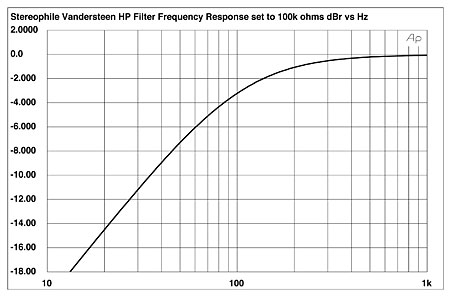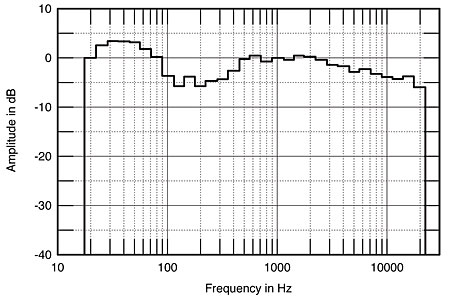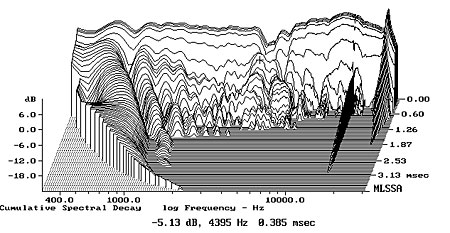| Columns Retired Columns & Blogs |
Vandersteen Audio Quatro loudspeaker Measurements
Sidebar 3: Measurements
My estimate of the Vandersteen Quatro's voltage sensitivity was both significantly lower than specified and lower than average, at 83dB(B)/2.83V/m. Fortunately, the speaker's impedance plot (fig.1) indicates that it is a very easy load, with a generally low electrical phase angle and an impedance that drops below 8 ohms only in the high treble. The minimum value was 7.6 ohms at 11.7kHz. The peak of 21.6 ohms at 68Hz indicates that this is the tuning frequency of the front-panel woofer, though the in-line high-pass filter will prevent this drive-unit from reproducing frequencies this low. Fig.2 shows the response of this filter set to the 100k ohm input impedance of the Audio Precision analyzer. The output is down 3.23dB at 100Hz, very close to the specified –3dB at this frequency, and the rollout slope is the expected 6dB/octave.

Fig.1 Vandersteen Quatro, electrical impedance (solid) and phase (dashed). (2 ohms/vertical div.)

Fig.2 Vandersteen Quatro, response of in-line high-pass filter, set for 100k ohm analyzer input impedance (2dB/vertical div.).
Other than a small glitch at 26.5kHz—the frequency of the metal-dome tweeter diaphragm's "oil-can" resonance—the impedance graph was free from the small discontinuities that would indicate the presence of cabinet resonances. Even with the cloth "sock" that covers the black-painted MDF rolled down, I found the Quatro's cabinet extremely inert. Fig.3 shows a cumulative spectral-decay plot calculated from the output of a simple accelerometer fastened to the Quatro's front baffle 6" below the woofer. Although four vibrational modes can be seen, the lowest in frequency lying at 418Hz, these are all well down in level; I think it safe to proclaim that they will have no effect on sound quality.

Fig.3 Vandersteen Quatro, cumulative spectral-decay plot calculated from the output of an accelerometer fastened to the cabinet's front baffle below the woofer, with sock rolled down (MLS driving voltage to speaker, 7.55V; measurement bandwidth, 2kHz).
The first acoustic measurements I took of the Quatro were of the individual drive-unit sections, on the tweeter axis at 50" with the sock rolled down, and with the amplifier driven by the in-line high-pass filter correctly set by measurement for its input impedance. These are shown in fig.4, along with the nearfield responses of the upper woofer and the midrange unit. The woofer rolls off a little earlier than the –3dB at 100Hz specified, though this is partly due to the effect of a shallow peak in the midrange. A broad overlap can be seen between the outputs of the woofer and midrange-tweeter sections, with the crossover slopes very shallow. The sharp notch visible at 4.6kHz appears to be the crossover frequency between the midrange unit and tweeter, and the response is plateaued up in the tweeter's passband, both of which suggest that the tweeter axis, which is 43" from the floor, is too high to be the intended listening axis.

Fig.4 Vandersteen Quatro, acoustic crossover on tweeter axis at 50" with sock rolled down, corrected for microphone response, with the nearfield responses of the upper woofer and midrange unit plotted below 350Hz; in-line high-pass filter correctly set for amplifier input impedance.
I performed almost all of the acoustic measurements on the midrange axis, which is 35" from the floor, 1" below the height of Michael Fremer's ears in his listening chair—though I note that when Richard Vandersteen set up the Quatros in Mikey's room, he tilted the speakers back very slightly with spikes. The tweeter resonance results in a sharp spike at 26.5kHz, but this is too high in frequency to have audible consequences. Other than slight suckouts at 750Hz and 5kHz, the response on this axis is impressively flat. The response on the woofer axis, which is 30" from the floor, is plotted in magenta in this graph. The upper-crossover suckout fills in, but the top two treble octaves shelve down, as Michael noted in his auditioning..
The sum of the nearfield midrange and upper-woofer responses is plotted below 300Hz in this graph, taking acoustic phase into account; the passive section's output is down by 3dB at 100Hz as specified, despite the woofer on its own appearing to roll off a little earlier. (The sum of the midrange unit and woofer responses is actually flatter in the midrange than the woofer by itself.) The colored traces to the left of this graph show the nearfield response of the Quatro's powered subwoofer module, with the Contour control set to its minimum (red trace), middle (blue), and maximum (green) positions. (The Quatro's 11-band equalizer was set to the control positions that Richard Vandersteen had determined to be optimal for MF's room, hence the rather lumpy appearance of these traces.) Basically, the Contour control trades off low-frequency extension against the amount of midbass boost. MF had it set to the middle position for his auditioning.
As suggested by figs. 4 and 5, the Quatro is very critical regarding the optimal listening axis, something that both MF and I found in our auditionings. Fig.6 shows how the response changes as the listener moves above and below the midrange axis. On the tweeter axis and above, a large suckout appears at the upper crossover frequency and the high treble shelves up; below the midrange axis, though the mid-treble is flatter overall, the high-treble and midrange outputs shelve down. In the horizontal plane (fig.7), the high upper-crossover frequency results in a considerable degree of flare at the bottom of the tweeter's passband, the midrange unit not maintaining its output off-axis in the top octave of its passband. This will tend to compensate for the lack of energy in the same region of midrange-axis response and result in an overall neutral treble balance in-room.

Fig.5 Vandersteen Quatro, anechoic response on midrange axis at 50" with sock in place, averaged across 30° horizontal window and corrected for microphone response, with the complex sum of the nearfield responses of the upper woofer and midrange unit plotted below 500Hz (black trace); the farfield response on the upper woofer axis (magenta); the nearfield responses of the subwoofer module with Contour set to "10" (green), "6" (blue), and "1" (red); and with 11-position equalizer set for MF's room acoustic.

Fig.6 Vandersteen Quatro, vertical response family at 50", normalized to response on midrange axis, from back to front: differences in response 15–5° above axis, reference response, differences in response 5–15° below axis.

Fig.7 Vandersteen Quatro, lateral response family at 50", normalized to response on midrange axis, from back to front: differences in response 90–5° off axis, reference response, differences in response 5–90° off axis.
This can be seen in fig.8, which shows the Quatro's spatially averaged in-room response taken in a grid centered on the position of MF's ears in his listening chair. The upper midrange and treble gently slope down in textbook manner. (Remember that a flat treble response is not optimal with an in-room measurement, which takes into account a speaker's power response.) My own auditioning of the Quatros in MF's room had led me to expect the shelved-up low bass in fig.8. What I did not expect was the lack of measured lower-midrange energy indicated by this graph—the Quatros didn't sound as though they lacked punch, which is generally the subjective result of this kind of response. But whether this measured lack is due to the Allison Effect (destructive interference between the speakers' direct sounds and their reflections from nearby boundaries), a suboptimally arranged crossover between the Quatro's passive section and the powered subwoofer, or even the settings of the active section's equalizer, I have no idea.

Fig.8 Vandersteen Quatro, spatially averaged, 1/3-octave response in MF's listening room.
In the time domain, the Quatro's impulse response on the midrange axis is time-coherent (fig.9). However, the step response (fig.10) reveals that, even on this axis, the tweeter's output slightly leads that of the midrange unit, suggesting that the optimum integration of the two units' outputs occurs just below this axis. On the other hand, as the horizontal dispersion graph (fig.7) indicates, the associated suckout on the midrange axis actually coincides with an excess of energy in-room. Quatro owners should experiment with the speakers' tiltback to get the most neutral perceived treble balance in their own rooms. All the drive-units are connected with the same positive acoustic polarity, by the way.

Fig.9 Vandersteen Quatro, impulse response on midrange axis at 50" (5ms time window, 30kHz bandwidth).

Fig.10 Vandersteen Quatro, step response on midrange axis at 50" (5ms time window, 30kHz bandwidth).
Finally, the Quatro's cumulative spectral-decay plot (fig.11) is impressively clean in the treble, though some delayed energy is associated with the on-axis suckouts.

Fig.11 Vandersteen Quatro, cumulative spectral-decay plot at 50" (0.15ms risetime).
Its use of first-order crossover filters makes the Vandersteen Quatro sensitive to set up. However, when it is set up optimally, its measured performance suggests that its owner will get a neutral sound balance and a time-coherent presentation, though I remain puzzled by that lack of lower-midrange energy in the in-room response.—John Atkinson
- Log in or register to post comments




































